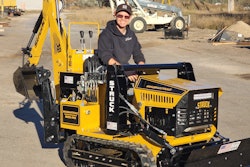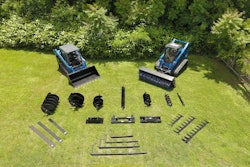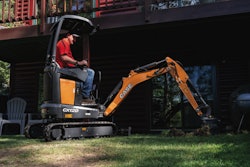
Experts from both interior and exterior landscaping companies have weighed in on how to establish safety programs in your company, how to implement them and the importance of staying closely involved in the process.
Starting from the top
For a program to see real and successful results, the driving force behind creation, implementation and follow through must begin with those in charge.
“As with anything implemented into a company, it starts from the top,” says Rich Arlington, president of Arlington Lawncare Inc., Erie, Pennsylvania. “If the owner takes a viable interest in the safety program, if the owner creates an environment where safety is foremost in people’s minds every day and in everything they do, then you’re going to have a successful, safe company.”
Arlington has been in the business of professional landscaping for over 30 years, and since 2004, his company has been awarded the National Association of Landscape Professionals’ (NALP) Safety Award.
With such a record behind him, Arlington says he’s convinced that leadership is key when it comes to beginning and executing any program within a company.
Connie Hom, owner of Buckingham Greenery Interior Landscapes in Buckingham County, Virginia, makes a point of discussing safety with employees as soon as they are hired to make sure they understand the program before work begins.
“As the owner of the company, I’m going to be very safety conscious and communicate that to the team, and we start that off right in the beginning,” she says. “Part of our orientation is a safety procedure manual that each team member reviews with me at the time of employment.”
Arlington notes that in his career, he’s seen many companies claim to have safety programs in effect, but when inspected closer, it’s obvious that the program is merely a concept or suggestion.
“If the owners say they have a safety program to get a discount on worker’s comp but don’t really act like they have a safety program, then they don’t have a safe company,” he says.
Creation, execution and benefits
When it comes to creating a safety program for your landscaping company, there are many avenues you can utilize.
For Arlington, he began by recalling some of the basic safety practices his parents taught him as a teenager, such as wearing safety glasses, earplugs and more. Once this base was established, he began becoming more acquainted with worker’s compensation and his insurance company.
From here, he began researching more about the standards set by the Occupational Safety and Health Administration (OSHA) and how the organization resolved problems.
When NALP began offering a safety program workshop, Arlington says he was one of the first in line to join. It was after participating in this program that he gained information on how to create a complete company safety program that included books, videos, tips, meeting information and more.
“Once we had physical stuff that we could distribute to people and talk about, it really transcended into a whole different realm of the safety program,” he says. “They would have the safety stuff come out in bilingual pamphlets as well.”
When Hom began creating her safety program, she enlisted the help of a safety consultant to create the manual and distribution materials. Hom has even had OSHA inspections performed, which she says helps ensure the company isn’t lacking in any safety capacity.
“I have everybody say, ‘You’re having an OSHA inspection?’ and I go, ‘yeah, but we’re safety conscious,’” she says. “So, whatever they tell us, it’ll make us better.”
Hom says once the OSHA inspection is complete, your company is given a time frame to have any infractions fixed before they return and re-check. This, she says, gives them more than enough time to correct any errors and educate the staff on proper procedures.
“I think there’s this preconceived perception that when OSHA finds something, they are quick to fine,” she says. “But they’re really there to help people protect their employees.”
Both Arlington and Hom have weekly safety meetings with their teams to keep everyone in the loop on what’s going on company-wide, what can be improved upon and what might be coming down the pipes.
“It’s the communication,” Hom says. “We believe that part of the safety is the training and education. It has to be the commitment to safety. We’ve talked a lot about safety because we care about the personal safety of our people.”
Arlington believes company owners need to have standard operating procedures in their companies that breed safety. One thing his company does to nail this point home is prohibiting employees from even backing up a truck and trailer without a spotter.
“That sounds like I don’t trust my guys, but it’s got nothing to do with that,” he says. “It’s got to do with whether or not someone’s going to walk behind that trailer, is there something in the blind spot? We just want to make sure nothing happens in the process of backing up that trailer. That’s where most of the accidents are going to happen.”
Along with the obvious perk of having a company reputation of being safe, Arlington and Hom agree that having effective safety programs can boost employee morale, save money on insurance costs, earn rewards and more.
“It all boils down to productivity,” Arlington says. “If you have an employee that’s hurt and working, they can’t perform at their maximum efficiency. If you have an employee that gets hurt and can’t come to work, then you’re down an experienced person.”
Arlington says that creating a safe environment boosts the morale of employees and helps give them a positive goal to work toward.
“From the team’s environment, it gives them something to feel like they’re part of it,” he says. “A lot of times in business, it’s hard to give your team something that they can feel they belong to once you get to a certain size. But they definitely know they are part of the team. It gives them a sense of companionship and a sense of belonging to something bigger than themselves.”
Maintaining safety
Both Arlington and Hom agree that once a company safety program is established and in full swing, the next step is to ensure that it retains its momentum and stays successful.
This, the experts agree, boils down to accountability on the part of the owners and employees.
“When your team members understand that safety is a very important aspect of the company, they’re more in tune to it,” Hom says. “We always say if you see somebody not doing something right, say something. Take action.”
Hom says when these instances are handled with positive reinforcement and in a manner that’s safe for all involved, there’s a better understanding and reaction to it.
For Hom, the safety precautions her company faces are slightly different from those of exterior landscaping companies, as her employees must be well-versed in the safety program of every company they partner with.
“It’s not because of the equipment we use, but it’s the places that we deal with on the inside,” she says. “It has a different perspective.”
When entering other businesses to install interior landscaping designs, Hom says her team must be aware of fire exits, emergency escapes, emergency action plans, safety programs and more that accompany the business.
“The interesting thing and the difference between interior and exterior landscaping is that if something happens on the outside, you would just leave the premises,” she says. “On the inside, if something were to happen, you have to follow the rules of that company.”
Arlington says a successful safety program starts and stops with the company owner. He stresses the importance of company owners taking ownership of creating, teaching and enforcing safety programs, as he says it’s too important of a job to delegate to someone else.
“A lot of times as owners, we get not so much complacent, but we feel that we’re too busy,” he says. “People will want to help with training programs, but they say they just don’t have time to train. I always tell owners if it’s important, you’ll make time.”











